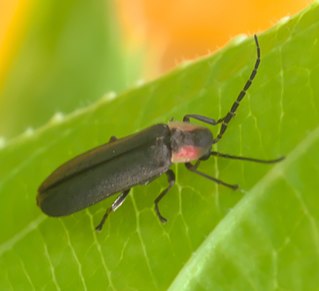Related Research Articles

Luciola is a genus of flashing fireflies in the family Lampyridae. They are especially well known from Japan and are often called Japanese fireflies, but their members range farther into Asia and reach southern Europe and Africa. This genus is traditionally held to extend to Australia, but these species do not seem to belong herein.

The Photinini are a large tribe of fireflies in the subfamily Lampyrinae. Photinus pyralis is famous in biotechnology for its luciferase gene. This is sometimes employed as a marker gene; genetically modified organisms which contain it start to glow like the firefly when brought in contact with a luciferin-containing medium. Firefly luciferases differ slightly between taxa, resulting in differently colored light and other properties, and in most cases where "firefly luciferase" is used in some application or study, it is the specific luciferase of P. pyralis.

The Lampyrini are a tribe of fireflies in the large subfamily Lampyrinae. The lineage formerly separated as Pleotomini seems to be a specialized offshoot of the Lampyrini not too distant from the type genus Lampyris and is therefore included here. This tribe occurs throughout the Holarctic and contains the typical "glowing" or "continuous-light" fireflies from that region. Some otherwise very advanced Lampyrini, like species in Paraphausis and Pyrocoelia, have degenerated light-producing organs again and communicate primarily or even exclusively with pheromones like the ancestors of the fireflies did.

Licininae is a subfamily of in the beetle family Cicindelidae. There are more than 80 genera and 1,800 described species in Licininae.

Epicauta is a genus of beetles in the blister beetle family, Meloidae. The genus was first scientifically described in 1834 by Pierre François Marie Auguste Dejean. Epicauta is distributed nearly worldwide, with species native to all continents except Australia and Antarctica. Surveys have found the genus to be particularly diverse in northern Arizona in the United States. Few species occur in the Arctic, with none farther north than the southern edge of the Northwest Territories, Canada.

Desmiphorini is a tribe of longhorn beetles of the subfamily Lamiinae.
Microphotus is a genus of fireflies in the family Lampyridae. Microphotus are usually found in the southwestern region of the United States of America and adjoining parts of Mexico. There are seven described species in Microphotus in the United States and three more in Mexico.

Pterostichini is a tribe of ground beetles in the subfamily Harpalinae. There are about 180 genera and more than 3,800 described species in Pterostichini.

Pyractomena is a genus of fireflies in the family Lampyridae. There are at least 20 described species in Pyractomena.

Aspisoma is a genus of fireflies in the family Lampyridae. There are at least 70 described species in Aspisoma.

Pyropyga is a genus of primarily North American fireflies in the beetle family Lampyridae. There are about 13 described species in Pyropyga. It is among the genera of Lampyridae where both sexes of adults have no bioluminescent organs.

Phengodes is a genus of glowworms in the beetle family Phengodidae. There are more than 30 described species in Phengodes.
Tenaspis is a genus of fireflies in the beetle family Lampyridae. There are about 18 described species in Tenaspis.
Bicellonycha is a genus of fireflies in the beetle family Lampyridae. There are more than 40 described species in Bicellonycha.

Lamprigera is a poorly resolved genus of fireflies or glow-worms in the subfamily Lampyrinae, possibly placed in tribe Photinini. Species of the genus Lamprigera are found in Asia.
Paraphotinus is a genus of Central American fireflies, distinguished from the closely related Photinus by the presence of ventral branches in their aedeagal parameres. It was recently elevated to genus level.
References
- ↑ "Photinus Genus Information". BugGuide.net. Retrieved 2018-02-27.
- ↑ "Photinus Report". Integrated Taxonomic Information System. Retrieved 2018-02-27.
- ↑ "Photinus Overview". Encyclopedia of Life. Retrieved 2018-02-27.
- ↑ "Browse Photinus". Catalogue of Life. Retrieved 2018-02-27.
- 1 2 3 4 5 6 7 8 9 10 11 12 13 14 15 16 17 18 19 20 21 22 23 24 25 26 27 28 29 30 31 32 33 34 35 36 Zaragoza-Caballero, Santiago; López-Pérez, Sara; Vega-Badillo, Viridiana; Domínguez-León, Daniel E.; Rodríguez-Mirón, Geovanni M.; González-Ramírez, Mireya; Gutiérrez-Carranza, Ishwari G.; Cifuentes-Ruiz, Paulina; Zurita-García, Martín L. (2020-02-13). "Luciérnagas del centro de México (Coleoptera: Lampyridae): descripción de 37 especies nuevas". Revista Mexicana de Biodiversidad. 91. Universidad Nacional Autonoma de Mexico. doi: 10.22201/ib.20078706e.2020.91.3104 . ISSN 2007-8706.